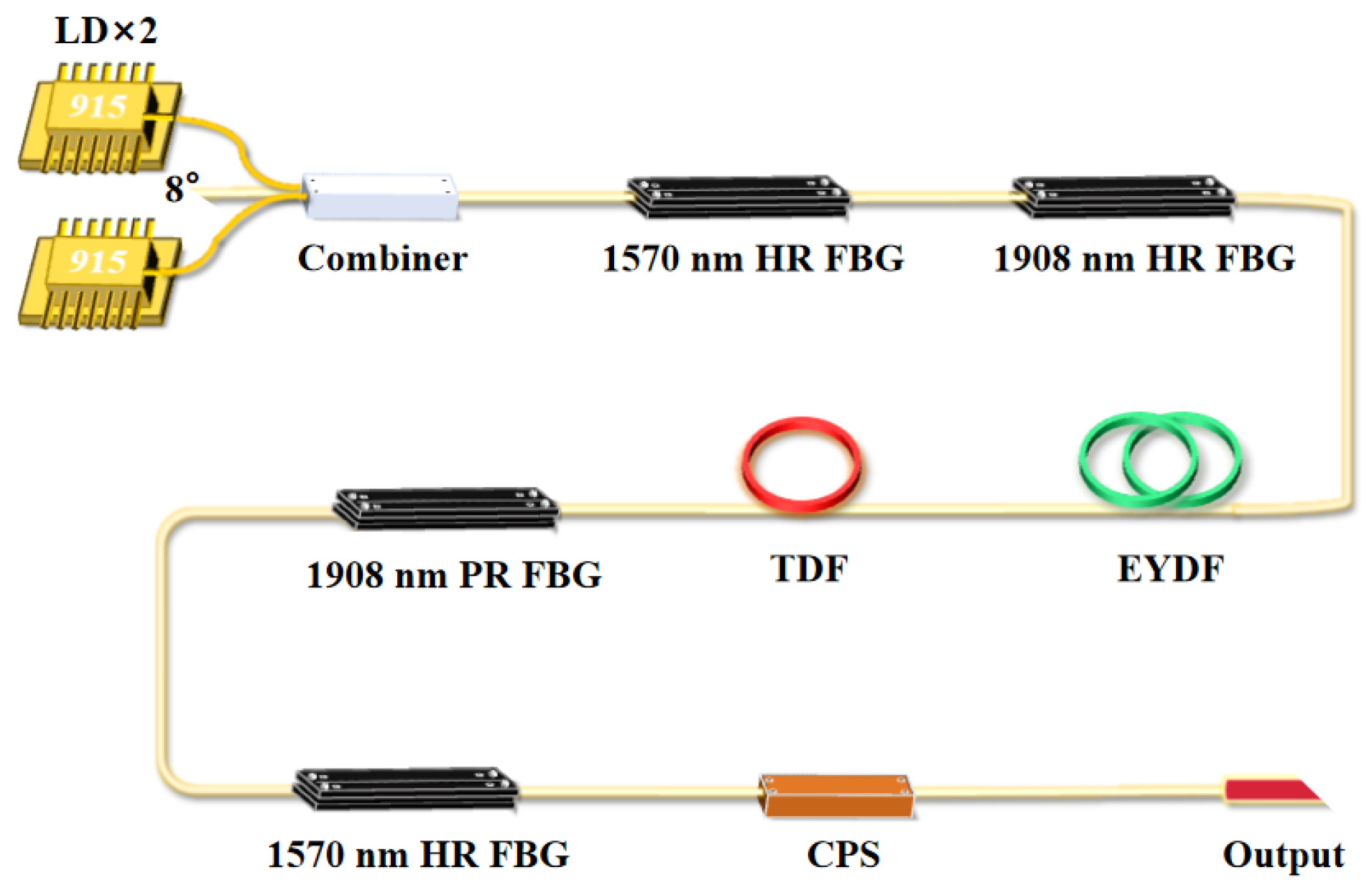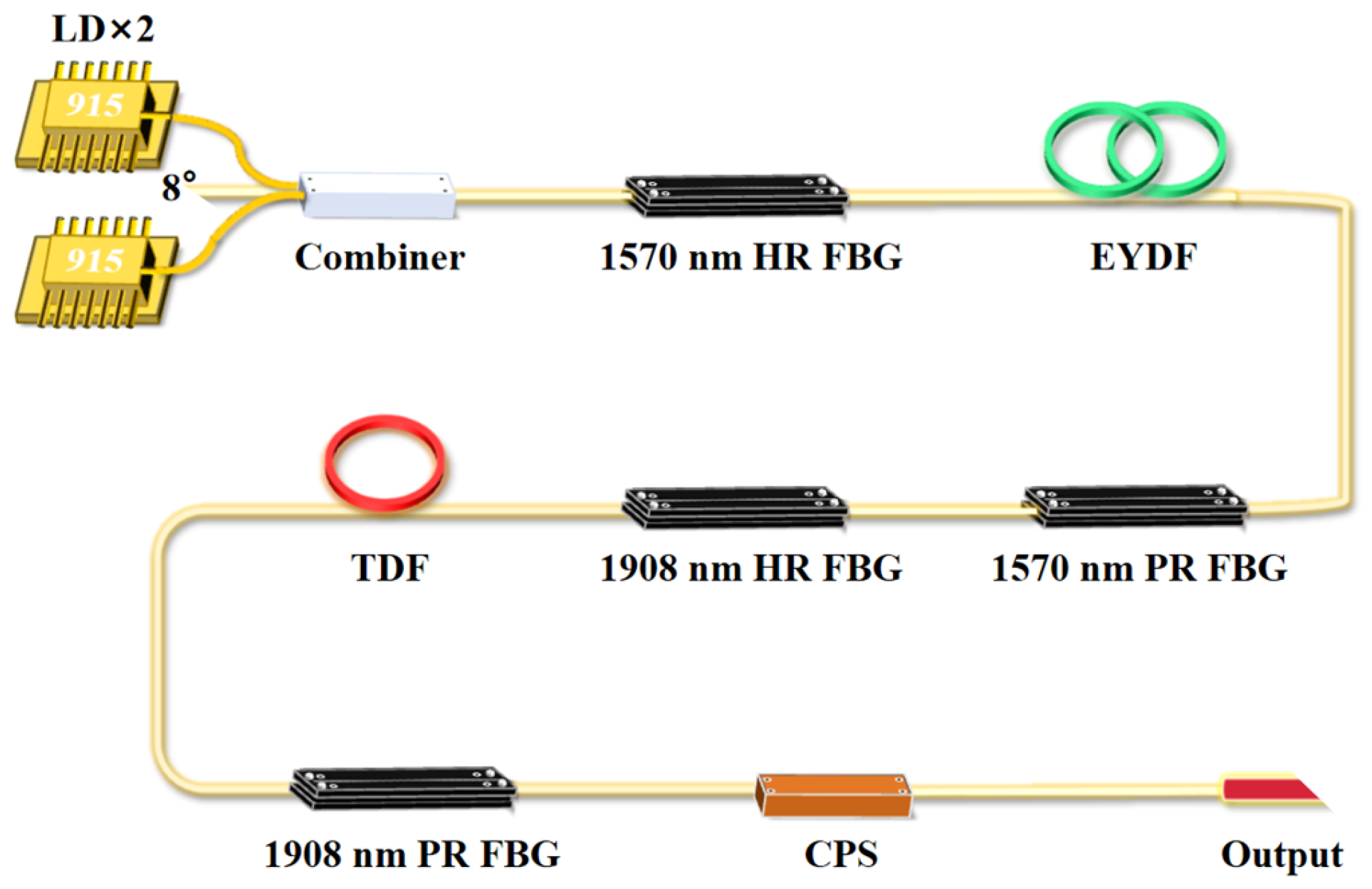A 1908 nm Internal-Cavity Tm-Doped Fiber Laser Pumped by a 1570 nm Er/Yb Fiber Laser
Abstract
1. Introduction
2. Experimental Setup
3. Experimental Results and Discussion
4. Conclusions
Author Contributions
Funding
Institutional Review Board Statement
Informed Consent Statement
Data Availability Statement
Conflicts of Interest
References
- Schneider, J.; Forster, P.; Romano, C.; Eichhorn, M.; Kieleck, C. High pulse energy ZnGeP2 OPO directly pumped by a Q-Switched Tm3+-doped single-oscillator fiber laser. Opt. Lett. 2021, 46, 2139. [Google Scholar] [CrossRef]
- Lv, Z.; Shen, Y.; Zong, N.; Bian, Q.; Wang, E.P.; Chang, J.Q.; Bo, Y.; Cui, D.A.; Peng, Q.J. 1.53 W all-solid-state nanosecond pulsed mid-infrared laser at 6.45 µm. Opt. Lett. 2022, 47, 1359–1362. [Google Scholar] [CrossRef] [PubMed]
- Tendean, M.; Mambu, T.D.B.; Tjandra, F.; Panelewen, J. The use of thulium-doped fiber laser (TDFL) 1940 nm as an energy device in liver parenchyma resection, a-pilot-study inindonesia. Ann. Med. Surg. 2020, 60, 491–497. [Google Scholar] [CrossRef] [PubMed]
- Pei, W.X.; Li, H.; Cui, Y.L.; Zhou, Z.Y.; Wang, M.; Wang, Z.F. Narrow-linewidth 2 μm all-fiber laser amplifier with a highly stable and precisely tunable wavelength for gas molecule absorption in photonic crystal hollow-core fibers. Molecules 2021, 26, 5323. [Google Scholar] [CrossRef] [PubMed]
- Deroh, M.; Xu, G.; Lucas, E.; Beugnot, J.C.; Maillotte, H.; Sylvestre, T.; Kibler, B. Towards 2-μm comb light source based on multiple four-wave mixing in a dual-frequency brillouin fiber laser. J. Eur. Opt. Soc. Rapid. 2024, 20, 9. [Google Scholar] [CrossRef]
- Svyatoslav, K.; Sophie, B.C. Isolator-free unidirectional thulium-doped fiber laser. Light Sci. Appl. 2015, 4, e340. [Google Scholar][Green Version]
- Lenski, M.; Heuermann, T.; Gebhardt, M.; Wang, Z.Y.; Gaida, C.; Jauregui, C.; Limpert, J. Inband-pumped, high-power thulium-doped fiber amplifiers for an ultrafast pulsed operation. Opt. Express 2022, 30, 44270–44282. [Google Scholar] [CrossRef]
- Fusari, F.; Vetter, S.; Lagatsky, A.A.; Richards, B.; Calvez, S.; Jha, A.; Dawson, M.D.; Sibbett, W.; Brown, C.T.A. Tunable laser operation of a Tm3+-doped tellurite glass laser near 2 μm pumped by a 1211 nm semiconductor disk laser. Opt. Mater. 2010, 32, 1007–1010. [Google Scholar] [CrossRef]
- Lenski, M.; Xu, Q.; Wang, Z.Y.; Gierschke, P.; Lauregui, C.; Limpert, J. High-power, air-cooled thulium doped fiber amplifier with 71% slope efficiency. EPJ Web Conf. 2024, 307, 2047. [Google Scholar] [CrossRef]
- Jackson, S.D.; King, T.A. Theoretical modeling of Tm-doped silica fiber lasers. J. Lightwave Technol. 1999, 17, 948–956. [Google Scholar] [CrossRef]
- Hanna, D.C.; Percival, R.M.; Smart, R.G. Efficient and tunable operation of a Tm-doped fiber laser. Opt. Commun. 1990, 75, 283–286. [Google Scholar] [CrossRef]
- Kotov, L.; Likhachev, M.; Bubnov, M.; Medvedkov, O.; Lipatov, D.; Guryanov, A.; Zaytsev, K.; Jossent, M.; Fevrier, S. Millijoule pulse energy 100-nanosecond Er-doped fiber laser. Opt. Lett. 2015, 40, 1189–1192. [Google Scholar] [CrossRef] [PubMed]
- Matniyaz, T.; Kong, F.T.; Kalichevsky, D.; Dong, M.T.K.; Dong, L. 302 W single-mode power from an Er/Yb fiber MOPA. Opt. Lett. 2020, 45, 3021. [Google Scholar] [CrossRef] [PubMed]
- Zhang, L.; Zhang, J.X.; Sun, Q.; Sun, S.; Shi, C.D.; Fu, S.J.; Bai, X.L.; Fang, Q.; Shi, W.; Yao, J.Q. Efficient multi-watt 1720 nm ring-cavity Tm-doped fiber laser. Opt. Express 2020, 28, 37910–37918. [Google Scholar] [CrossRef] [PubMed]
- Zhang, L.; Sheng, J.X.; Sheng, Q.; Fu, S.J.; Shi, W.; Yao, J.Q. High-efficiency thulium-doped fiber laser at 1.7 μm. Opt. Laser Technol. 2022, 152, 108180. [Google Scholar] [CrossRef]
- Chen, H.; Chen, S.P.; Jiang, Z.F.; Hou, J. Diversified pulse generation from frequency shifted feedback Tm-doped fiber lasers. Sci. Rep. 2016, 6, 26431. [Google Scholar]
- Hemming, A.; Simakov, N.; Haub, J.; Carter, A. A review of recent progress in holmium-doped silica fibre sources. Opt. Fiber Technol. 2014, 20, 621–630. [Google Scholar] [CrossRef]
- Creeden, D.; Johnson, B.R.; Rines, G.A.; Setzler, S.D. High power resonant pumping of Tm-doped fiber amplifiers in core- and cladding-pumped configurations. Opt. Express 2014, 22, 29067–29080. [Google Scholar] [CrossRef]
- Creeden, D.; Johnson, B.R.; Setzler, S.D.; Chicklis, E.P. Resonantly pumped Tm-doped fiber laser with >90% slope efficiency. Opt. Lett. 2014, 39, 470–473. [Google Scholar]
- Liu, F.; Liu, P.; Feng, X.; Wang, C.L.; Yan, Z.J.; Zhang, Z.W. Tandem-pumped, tunable thulium-doped fiber laser in 2.1 μm wavelength region. Opt. Express 2019, 27, 8283. [Google Scholar] [CrossRef]
- Wang, Y.; Yang, J.L.; Huang, C.Y.; Luo, Y.F.; Wang, S.W.; Tang, Y.L.; Xu, J.Q. High power tandem-pumped thulium-doped fiber laser. Opt. Express 2015, 23, 2991. [Google Scholar] [CrossRef]









Disclaimer/Publisher’s Note: The statements, opinions and data contained in all publications are solely those of the individual author(s) and contributor(s) and not of MDPI and/or the editor(s). MDPI and/or the editor(s) disclaim responsibility for any injury to people or property resulting from any ideas, methods, instructions or products referred to in the content. |
© 2025 by the authors. Licensee MDPI, Basel, Switzerland. This article is an open access article distributed under the terms and conditions of the Creative Commons Attribution (CC BY) license (https://creativecommons.org/licenses/by/4.0/).
Share and Cite
Li, Y.; Wang, Y.; Zhang, D.; Hu, H.; Zhou, W.; Cai, X.; Yan, W.; Mao, G.; Liu, M.; Li, P. A 1908 nm Internal-Cavity Tm-Doped Fiber Laser Pumped by a 1570 nm Er/Yb Fiber Laser. Photonics 2025, 12, 1036. https://doi.org/10.3390/photonics12101036
Li Y, Wang Y, Zhang D, Hu H, Zhou W, Cai X, Yan W, Mao G, Liu M, Li P. A 1908 nm Internal-Cavity Tm-Doped Fiber Laser Pumped by a 1570 nm Er/Yb Fiber Laser. Photonics. 2025; 12(10):1036. https://doi.org/10.3390/photonics12101036
Chicago/Turabian StyleLi, Yang, Yunpeng Wang, Dongming Zhang, Hailin Hu, Wentao Zhou, Xinyu Cai, Weinan Yan, Guanjie Mao, Ming Liu, and Pingxue Li. 2025. "A 1908 nm Internal-Cavity Tm-Doped Fiber Laser Pumped by a 1570 nm Er/Yb Fiber Laser" Photonics 12, no. 10: 1036. https://doi.org/10.3390/photonics12101036
APA StyleLi, Y., Wang, Y., Zhang, D., Hu, H., Zhou, W., Cai, X., Yan, W., Mao, G., Liu, M., & Li, P. (2025). A 1908 nm Internal-Cavity Tm-Doped Fiber Laser Pumped by a 1570 nm Er/Yb Fiber Laser. Photonics, 12(10), 1036. https://doi.org/10.3390/photonics12101036



